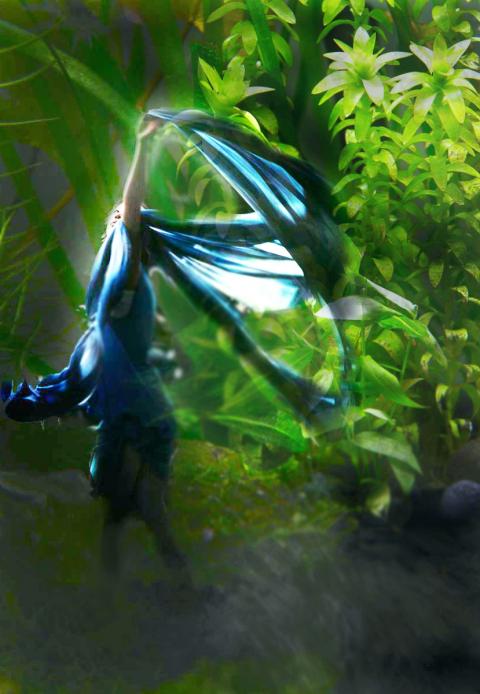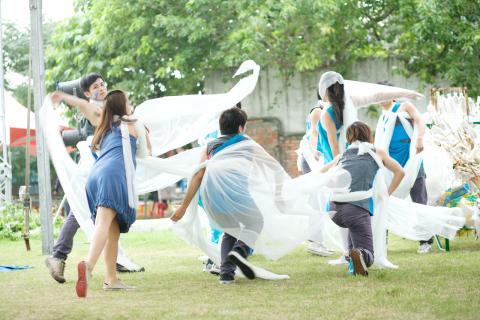Dance and choreography are often described in terms of liquidity or fluidity of movement. This afternoon a group of young Taiwanese dancers will use their bodies to focus attention on the most precious fluid of all — water — and the need for safe drinking water for everyone, as part of a 24-hour worldwide event, Global Water Dances.
The project is the brainchild of 11 Laban Movement analysts who were inspired by a dance and the environment conference they attended in England in 2009. (Labanotation and Laban Movement Analysis were first developed by Rudolf Laban in the early 20th century as a way of describing, notating and recording human movement used by dancers, physical therapists and others.) The 11 all had experience with Laban’s idea of Movement Choirs, which are events aimed at creating social cohesion through community dances. Planning for tomorrow’s event began last year with the creation of a Web site and networking.
Global Water Dances begins in Pacific Rim nations and travels westward around the world, involving dancers, musicians and other artists in 60 cities. It can be followed online at globalwaterdances.org.

Photo Courtesy of Chen Yi-shu, Dancecology
The Taiwanese portion has been organized by a two-year-old troupe called Dancecology (舞蹈生態系創意團隊), founded and directed by Peng Hsiao-yin (彭筱茵), a former member of the Neo-Classical Dance Company (新古典舞團) who received her MFA from the Graduate Institute of Choreography at Taipei National University of the Arts (TNUA). She wanted to move beyond the traditional limits of stage-bound performance to focus on environmental theater, hence the thinking behind the troupe’s name — dance plus ecology, or Dancecology.
Since the group’s founding, it has performed at the 2009 Kuandu Arts Festival, the Taipei Fine Arts Museum, Juming Museum and, earlier this year, at the Taipei International Flora Expo. It was selected as the 2009-2010 artist-in-residence at the TNUA KD Art Culture Industry Innovation Incubation Center. The company joined the Global Water Dances lineup at the end of last year.
Peng’s work is usually site specific and today’s show will take place in the viewing area in front of Zhuwei Wharf (竹圍碼頭) in Tamsui, which is a short walk along the bikeway from the Zhuwei MRT Station (竹圍捷運站). It is also the site of Plum Tree Creek (樹梅坑溪), which was the inspiration for Peng’s portion of the program.

Photo Courtesy of Chen Yi-shu, Dancecology
In her program notes Peng said the creek, a branch of the Tamsui River, was once the only source of fresh water in the Zhuwei area, but rapid development has left it little more than a gutter. Starting last year, several historians, artists and local residents banded together to draw awareness to the creek’s plight and push for its restoration.
Eight dancers and two musicians will be performing this afternoon, joined by children from Zhuwei Elementary School for sections three and four (“The Water Dance” and “Confluence”), which are the global collective portions of the program.
Peng choreographed the first two sections: “Flowing with Water,” which she said will gather the energy of participants and flow along with the Plum Tree Creek, and “The Story of Plum Tree Creek,” telling how humans change and damage nature.
To encourage people to get involved in helping to save the creek and protect Taiwan’s environment, audience members will be invited to join the dancers at several points during the show. For example, when the dancers who are portraying the creek are being polluted by the dancers who are playing the role of garbage, “we’ll invite the audience to save them,” Peng said. In “Confluence,” the troupe’s dancers will lead the audience in a group dance. In “The Water Dance,” dancers and volunteers will perform the same moves that are being danced around the world today.
In addition, after the show audience members will be invited to take a pledge to treasure water resources and reduce daily water pollution. Those who do will be invited to add their handprints to a long roll of paper.
The idea is to turn the paper into a “river of hands,” Peng said.
Dancecology notified us after the paper went to press that because of the advent of Typhoon Meari, their performance will be postponed until next Saturday, July 2, at 5pm at the same location.

On April 26, The Lancet published a letter from two doctors at Taichung-based China Medical University Hospital (CMUH) warning that “Taiwan’s Health Care System is on the Brink of Collapse.” The authors said that “Years of policy inaction and mismanagement of resources have led to the National Health Insurance system operating under unsustainable conditions.” The pushback was immediate. Errors in the paper were quickly identified and publicized, to discredit the authors (the hospital apologized). CNA reported that CMUH said the letter described Taiwan in 2021 as having 62 nurses per 10,000 people, when the correct number was 78 nurses per 10,000

As Donald Trump’s executive order in March led to the shuttering of Voice of America (VOA) — the global broadcaster whose roots date back to the fight against Nazi propaganda — he quickly attracted support from figures not used to aligning themselves with any US administration. Trump had ordered the US Agency for Global Media, the federal agency that funds VOA and other groups promoting independent journalism overseas, to be “eliminated to the maximum extent consistent with applicable law.” The decision suddenly halted programming in 49 languages to more than 425 million people. In Moscow, Margarita Simonyan, the hardline editor-in-chief of the

Six weeks before I embarked on a research mission in Kyoto, I was sitting alone at a bar counter in Melbourne. Next to me, a woman was bragging loudly to a friend: She, too, was heading to Kyoto, I quickly discerned. Except her trip was in four months. And she’d just pulled an all-nighter booking restaurant reservations. As I snooped on the conversation, I broke out in a sweat, panicking because I’d yet to secure a single table. Then I remembered: Eating well in Japan is absolutely not something to lose sleep over. It’s true that the best-known institutions book up faster

Though the total area of Penghu isn’t that large, exploring all of it — including its numerous outlying islands — could easily take a couple of weeks. The most remote township accessible by road from Magong City (馬公市) is Siyu (西嶼鄉), and this place alone deserves at least two days to fully appreciate. Whether it’s beaches, architecture, museums, snacks, sunrises or sunsets that attract you, Siyu has something for everyone. Though only 5km from Magong by sea, no ferry service currently exists and it must be reached by a long circuitous route around the main island of Penghu, with the